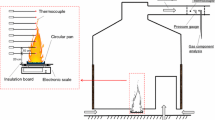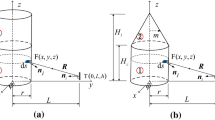Abstract
To investigate low air pressure effect on the flame radiative feedback to the fuel surface, pool fires with stable liquid surface were performed by employing three round burners with diameters of 0.15 m, 0.25 m and 0.35 m in both Lhasa (3650 m/64 kPa) and Hefei (24 m/100.8 kPa). Incident heat flux at fuel surface, flame shape and axial temperature distribution were compared at two sites. The flame envelope for 0.15 m appears to be cylinder, while that for 0.35 m tends to be cone, and the mean flame height is larger in reduced pressure for the same pool dimension. The averaged flame temperature is relatively higher in Lhasa due to reduction in air entrainment and thermal radiation loss, and the axial temperature rises could be scaled in the form of \(z\left( {{P \mathord{\left/ {\vphantom {P Q}} \right. \kern-0pt} Q}} \right)^{2/5}\). Experimental findings also reveal that low pressure reduces the radiation feedback evidently for different scale pool fires and the averaged value could be correlated against \(T_{\text{f}}^{5} P^{2} L_{\text{m}}\). The radiation feedback fraction \(X_{\text{a}}\) is around 0.30 for 0.15 m pool fires, while it is 0.55 in Lhasa for 0.35 m pool fire, lower than 0.76 in Hefei.









Similar content being viewed by others
Abbreviations
- \(c_{\text{p}}\) :
-
Specific heat of fuel (J kg−1K−1)
- C :
-
Constant (–)
- \(C_{\text{p}}\) :
-
Specific heat of air (J kg−1K−1)
- \(D\) :
-
Diameter of the pool (m)
- \(f_{\text{v}}\) :
-
Soot volume fraction (–)
- \(g\) :
-
Gravitational acceleration (m s−2)
- \(h\) :
-
Convective coefficient (W m−2 K)
- \(k\) :
-
Conductive coefficient (W m−2)
- \(L_{\text{m}}\) :
-
Mean beam length (m)
- \(\dot{m}\) :
-
Mass loss rate (g s−1)
- \(\dot{m}^{{\prime \prime }}\) :
-
Burning intensity, or mass loss per unit area (g m−2 s−1)
- P :
-
Pressure (kPa)
- \(\dot{q}_{\text{r}}^{\prime \prime }\) :
-
Radiative heat flux (kW m−2)
- \(Q\) :
-
Heat released (kW)
- \(\dot{Q}_{\text{absorption}}\) :
-
Radiative heat absorbed by fuel (kW)
- \(\dot{Q}_{{{\text{feedback}},{\text{rad}}}}\) :
-
Radiative heat feedback from flame (kW)
- \(\dot{Q}_{\text{fuel}}\) :
-
The heat needed for evaporation of the fuel burned (kW)
- \(\dot{Q}^{*}\) :
-
Dimensionless heat release rate (–)
- \(T_{0}\) :
-
Initial fuel temperature (K)
- \(T_{\text{boil}}\) :
-
Fuel boiling temperature (K)
- \(T_{\text{f}}\) :
-
Flame temperature (K)
- \(T_{\text{s}}\) :
-
Fuel surface temperature (K)
- \(T_{\infty }\) :
-
Ambient temperature (K)
- \(X_{\text{a}}\) :
-
The radiation fraction (K)
- \(z_{\text{f}}\) :
-
Flame height (m)
- \(z^{*}\) :
-
Dimensionless characteristic length (–)
- \(\Delta H_{\text{c}}\) :
-
Heat of combustion (kJ kg−1)
- \(\alpha\) :
-
The absorption fraction (–)
- \(\alpha_{\uplambda}\) :
-
The absorption fraction (–)
- \(\kappa\) :
-
Absorption coefficient (m−1)
- \(\kappa_{\text{s}}\) :
-
Soot absorption coefficient (m−1)
- \(\rho_{\uplambda}\) :
-
The reflection fraction (–)
- \(\rho_{\infty }\) :
-
Ambient air density (kg m−3)
- \(\sigma\) :
-
Stefan–Boltzmann constant (W m−2 K−4)
- \(\tau_{\uplambda}\) :
-
The transparent fraction (–)
- \(\phi\) :
-
Configuration factor (–)
References
Koseki H, Hayasaka H. Estimation of thermal balance in heptane pool fire. J Fire Sci. 1989;7(4):237–50.
Joulain P. The behavior of pool fires: state of the art and new insights. In: Symposium (international) on combustion. Elsevier; 1998.
Ditch BD. Pool fires—an empirical correlation. Combust Flame. 2013;160(12):2964–74.
Hamins A, Yang JC, Kashiwagi T. A global model for predicting the burning rates of liquid pool fires. Gaithersburg: US Department of Commerce, Technology Administration, National Institute of Standards and Technology; 1999.
De Ris J. Fire radiation—a review. In: Symposium (international) on combustion. Elsevier; 1979.
Hamins A, Fischer SJ, Kashiwagi T, Klassen ME, Gore JP. Heat feedback to the fuel surface in pool fires. Combust Sci Technol. 1994;97(1–3):37–62.
Hu L, Liu S, Wu L. Flame radiation feedback to fuel surface in medium ethanol and heptane pool fires with cross air flow. Combust Flame. 2013;160(2):295–306.
Nasr A, Suard S, El-Rabii H, Garo JP, Gay L, Rigollet L. Heat feedback to the fuel surface of a pool fire in an enclosure. Fire Saf J. 2013;60:56–63.
Richard J, Garo JP, Souil JM, Vantelon JP, Lemonnier D. Addition of a water mist on a small-scale liquid pool fire: effect on radiant heat transfer at the surface. Proc Combust Inst. 2002;29(1):377–84.
Yao W, Yin J, Hu X, Wang J, Zhang H. Numerical modeling of liquid n-heptane pool fires based on heat feedback equilibrium. Procedia Eng. 2013;62:377–88.
Krishnamoorthy G, Borodai S, Rawat R, Spinti J, Smith PJ. Numerical modeling of radiative heat transfer in pool fire simulations. In: ASME 2005 international mechanical engineering congress and exposition. American Society of Mechanical Engineers; 2005.
Consalvi J, Demarco R, Fuentes A. Modelling thermal radiation in buoyant turbulent diffusion flames. Combust Theor Model. 2012;16(5):817–41.
Sikanen T, Hostikka S. Modeling and simulation of liquid pool fires with in-depth radiation absorption and heat transfer. Fire Saf J. 2016;80:95–109.
Liu JH, Li J, Fan CG. A bibliometric study of pool fire related publications. J Therm Anal Calorim. 2020;63:104030.
Li P, Liu JH, Chen MY, Wang FL, Yuen R, Wang J. Experimental study of high altitude effect on heat release rates of pool fires using calorimeters. J Therm Anal Calorim. 2018;131(2):1597–603.
Hu X, He Y, Li Z, Wang J. Combustion characteristics of n-heptane at high altitudes. Proc Combust Inst. 2011;33(2):2607–15.
Yao W, Zhang J, Nadjai A, Beji T, Delichatsios MA. A global soot model developed for fires: validation in laminar flames and application in turbulent pool fires. Fire Saf J. 2011;46(7):371–87.
Yao W, Zhang J, Nadjai A, Beji T, Delichatsios MA. Development and validation of a global soot model in turbulent jet flames. Combust Sci Technol. 2012;184(5):717–33.
Fang J, Tu R, Guan J, Wang J, Zhang Y. Influence of low air pressure on combustion characteristics and flame pulsation frequency of pool fires. Fuel. 2011;90(8):2760–6.
Tu R, Fang J, Zhang YM, Zhang J, Zeng Y. Effects of low air pressure on radiation-controlled rectangular ethanol and n-heptane pool fires. Proc Combust Inst. 2013;34(2):2591–8.
Zhou ZH, Yao W, Li HH, Yuen R, Wang J. Experimental analysis of low air pressure influences on fire plumes. Int J Heat Mass Tran. 2014;70:578–85.
Liu JH, Zhou ZH. Examination of radiative fraction of small-scale pool fires at reduced pressure environments. Fire Saf J. 2019;110:102894.
De Ris JL, Wu PK, Heskestad G. Radiation fire modeling. Proc Combust Inst. 2000;28(2):2751–9.
Tao ZX, Yang R, Li C, Yao YN, Zhu P, Zhang H. Experimental study on liquid fire behavior at different effective ceiling heights in a full-size simulated cargo compartment. J Therm Anal Calorim. 2018;133(3):1617–26.
Jiang F, de Ris JL, Qi H, Khan MM. Radiation blockage in small scale PMMA combustion. Proc Combust Inst. 2011;33(2):2657–64.
Consalvi J, Liu F. Radiative heat transfer through the fuel-rich core of laboratory-scale pool fires. Combust Sci Technol. 2014;186(4–5):475–89.
Li Z, Liu N, Xie X, Zhang L, Guo X, Tu R. Heat transfer blockage effect of small-scale PMMA flame under exterior heat radiation. Int J Therm Sci. 2017;122:26–32.
International Organization for Standardization. Draft International Standard ISO/DIS 7240-15, Fire Detection and Alarm Systems, in Part 15. Point Type Multisensor (Light and Heat) Fire Detectors. 2002.
Luo M, He Y, Beck V. Application of field model and two-zone model to flashover fires in a full-scale multi-room single level building. Fire Saf J. 1997;29(1):1–25.
Hottel HC. Certain laws governing the diffusive burning of liquid—a review. Fire Res Abs Rev. 1959;1:41–4.
Hu L, Hu J, Liu S, Tang W, Zhang X. Evolution of heat feedback in medium pool fires with cross air flow and scaling of mass burning flux by a stagnant layer theory solution. Proc Combust Inst. 2015;35(3):2511–8.
Li ZH, He YP, Zhang H, Wang J. Combustion characteristics of n-heptane and wood crib fires at different altitudes. Proc Combust Inst. 2009;32(2):2481–8.
Zhou Z, Yao W, Hu X, Yuen R, Wang J. Experimental study of the burning behavior of n-heptane pool fires at high altitude. Fire Mater. 2016;40:80–8.
Liu J, Li P, Chen M, Chen X, Yuen R, Wang J. Experimental study on burning behaviors of liquid fuels with different sooting levels at high altitude. Therm Sci. 2017;21(6A):2527–35.
Heskestad G. Fire plume air entrainment according to two competing assumptions. In: Symposium (international) on combustion. Elsevier; 1988.
McCaffery BJ. Purely buoyant diffusion flames: some experimental results. Final report. Washington (DC): National Bureau of Standards, US Department of Commerce. Available from: NTIS, Springfield, VA. NBSIR 79-1910, 1979.
Quintiere J, Grove B. A unified analysis for fire plumes. In: Symposium (international) on combustion. Elsevier; 1998.
Heskestad G. Virtual origins of fire plumes. Fire Saf J. 1983;5(2):109–14.
Matthews L, Longenbaugh R. Radiative flux measurements in a sooty pool fire. Exp Heat Trans Int J. 1989;2(3):189–99.
Suo-Anttila JM, Blanchat TK, Ricks AJ, Brown AL. Characterization of thermal radiation spectra in 2 m pool fires. Proc Combust Inst. 2009;32(2):2567–74.
Sivaramakrishnan R, Comandini A, Tranter RS, Brezinsky K, Davis SG, Wang H. Combustion of CO/H2 mixtures at elevated pressures. Proc Combust Inst. 2007;31(1):429–37.
Beji T, Zhang JP, Yao W, Delichatsios M. A novel soot model for fires: validation in a laminar non-premixed flame. Combust Flame. 2011;158(2):281–90.
Orloff L, de Ris JL. Froude modeling of pool fires. In: Symposium (international) on combustion. Elsevier; 1982.
Zarzecki M, Quintiere JG, Lyon RE, Rossmann T, Diez FJ. The effect of pressure and oxygen concentration on the combustion of PMMA. Combust Flame. 2013;160(8):1519–30.
Luketa A. Assessment of simulation predictions of hydrocarbon pool fire tests. SAND2010-2511, Sandia National Laboratories, Albuquerque, New Mexico, 2010. 87185.
Yavas O, Leiderer P, Park HK, Grigoropoulos CP, Poon CC, Leung WP, Tam AC. Optical reflectance and scattering studies of nucleation and growth of bubbles at a liquid-solid interface induced by pulsed laser heating. Phys Rev Lett. 1993;70(12):1830–3.
Nakakuki A. Heat transfer in pool fires at a certain small lip height. Combust Flame. 2002;131(3):259–72.
Adiga KC, Ramaker DE, Tatem PA, Williams FW. Modeling pool-like gas flames of propane. In: Proceedings of the second international symposium on fire safety science. London: Elsevier; 1988. pp. 241–50.
Acknowledgements
This research was supported by the National Natural Science Foundation of China (Nos. 51376172 and 51909152) and Shanghai Sailing Program (Grant No. 18YF1409600). The authors deeply appreciate that.
Author information
Authors and Affiliations
Corresponding author
Additional information
Publisher's Note
Springer Nature remains neutral with regard to jurisdictional claims in published maps and institutional affiliations.
Rights and permissions
About this article
Cite this article
Li, P., Liu, J., Zhang, D. et al. Experimental study of reduced pressure effect on radiation feedback to the fuel surface of pool fires. J Therm Anal Calorim 144, 883–893 (2021). https://doi.org/10.1007/s10973-020-09545-7
Received:
Accepted:
Published:
Issue Date:
DOI: https://doi.org/10.1007/s10973-020-09545-7




